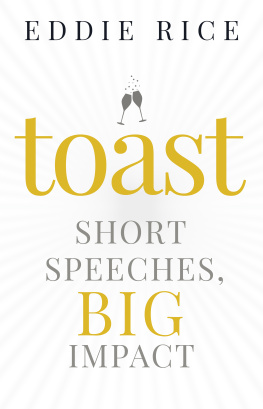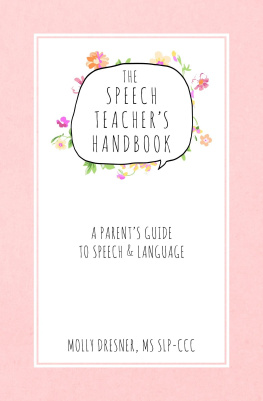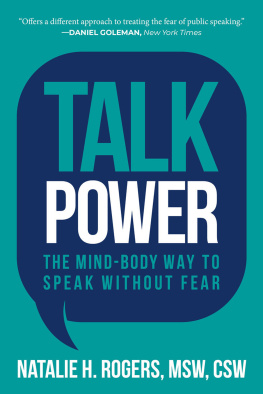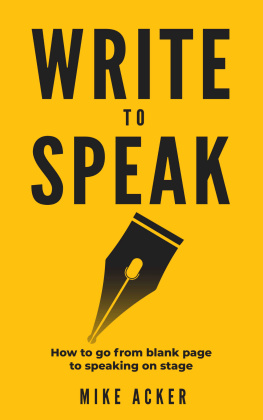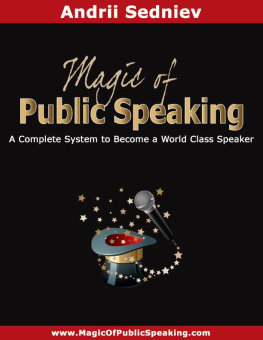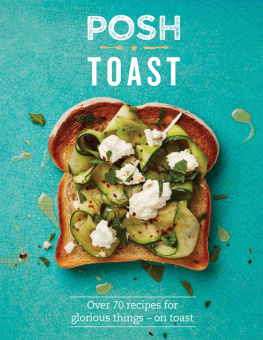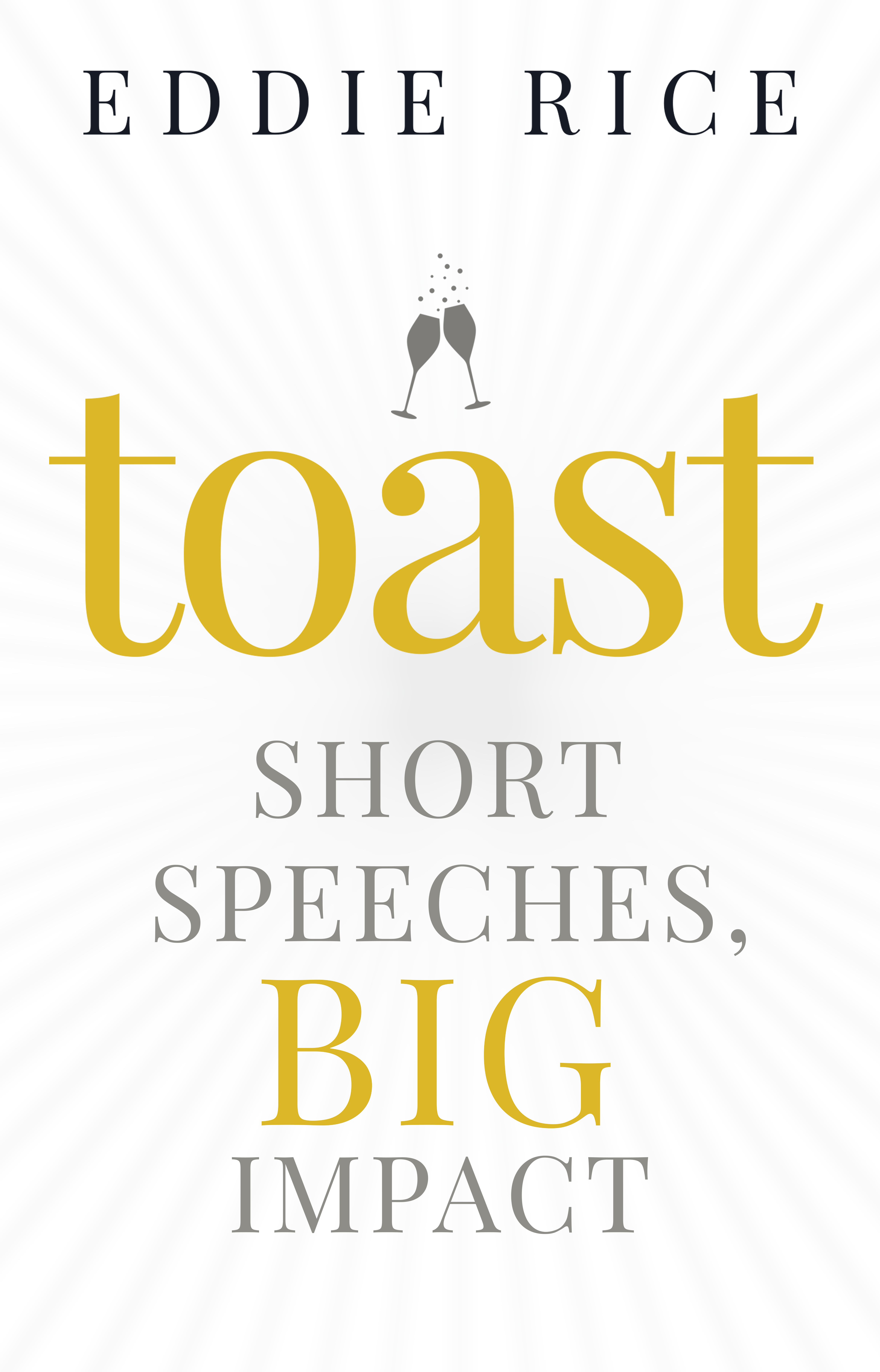toast
Short Speeches,
Big Impact
EDDIE RICE
Copyright 2022 by Eddie Rice
All rights reserved. This book or any portion thereof may not be reproduced or used in any manner whatsoever without the express written permission of the publisher except for the use of brief quotations in a book review.
ISBN e-book : 978-1 - 0880-3246 -6
ISBN paperback: 978-1 - 0880-3245 -9
CONTENTS
Introduction
Let me tell you a story about bombing at public speaking.
I was part of a Toastmasters groupa group dedicated to improving the communication and leadership skills of its members worldwide. Each year, they had a series of successive contests for different types of speeches. I entered the Humorous Speech contest and their Table Topics contest (the latter where you would get a random question and answer it between one to two minutes).
The first night and level were with my local club. I dont remember the exact topic of the speech, but I do remember making everyone laugh. I killed that night. Each joke landed; each funny story created laughs. Adrenaline and endorphins rushed through me.
The next competition level was in front of a much larger group of peoplemany of whom I didnt know. I wore my best suit. I started with the first joke. Silence. Followed by the next joke. Tepid laughter. I told more stories and jokes, or what I thought were jokes. Silence. Polite applause ended the speech.
Then the Table Topics competition came. The emcee asked the questionsomething straightforward and basicand I blanked. I was still reeling with emotion from bombing my humorous speech that I was now blanking out for this competition. I strung a few sentences together, but it wasnt enough for anything coherent. I sat down, deflated and defeated.
I tell this story for a few reasons.
First, I didnt let that one failure hold me back from continuing to improve at public speaking and doing it again. I wish I could tell you that I returned to the competition the next year to win it all in movie-like fashion. No, instead, I found more opportunities to speak and to write. I went on to teach others how to be public speakers and write great speeches.
Second, I made it my mission to prevent others from going through the same things I had. I dont want you to fail at your next speech; instead, it is my hope that by the time you finish this book you will be fully prepared to give an excellent toast.
Third, simply failing once at something shouldnt be the story or limiting belief that you allow it to be. You may have a time in your life where you failed at giving a speech or wish you had done better. Dont allow the fear associated with that one event to hold you back. Instead, tell yourself a different story, a story that says it was one moment and there will be many more opportunities to succeed.
Fourth, I didnt prepare enoughI practiced alone without feedbackwhich caused an uneven speech performance. I didnt get consistent laughs because my material wasnt consistent.
Finally, I thought I could wing it, but the best spontaneous messages come from preparation. Comics make it look easy, but thats because we dont get to see all the material they have discarded or withhold for when the situation arises.
Im now here to help you avoid what I went through. Whether thats through my book Toast or by helping you create the speech of your life.
Why I Wrote This Book
The shortest speeches in our lives, for our biggest moments, generate the greatest anxiety. We freeze up when asked, Can you just say a few words?
I have helped hundreds of people, like you, write speeches on many occasions. From the quick wedding toast to TEDx speeches to conference keynotes, I have shown speakers how to hone their ideas, brainstorm, then structure and craft speeches that move their audiences. This book will take the same approach I have used to help hundreds of regular people become confident speakers, and it will show you how to apply it each step along the way.
Anyone can write a great toast . This book is going to make sure you know how. I will take you through each step of the same speech writing process I do with my clients, giving you the skills to create a memorable toast without the fear and frustration you would face if you tried to go it alone. By the end, you will have made a great short speech fitting for its occasion.
This book is for anyone who needs to write a brief speech for a ceremonial occasion: wedding toasts, retirement toasts, award acceptance toasts, promotion toasts, and commemorative toasts. You can apply the process I outline in this book to any quick speech you give.
My Process with Clients
If you were my client for a speech, we would start with a brainstorming questionnaire followed by a more in-depth conversation over the phone. From there, I would create a first draft for your review, and we would trade drafts back and forth throughout the editing process. I would then give you tips on how to rehearse and memorize your speech at the end of the process.
Since we cant have a conversation through a book, Ive attempted to replicate that process as much as possible through prompts, questions, and exercises.
My Seven-Day Toast Writing Process
By spreading it over seven days, you can take the same process I use with my clients and apply it to your own toast. Over the first five days, you will brainstorm, structure, write, and edit your toast. On days six through seven, youll rehearse and memorize. You can do these days successively or spread them out if you have the time leading up to your toast.
Brainstorming
My process with clients starts with a brainstorming session fueled by a questionnaire of key prompts that get the ideas flowing. These ideas form the basis of the toast. You want a set of ideas to work from that can be sculpted into a toast. This section of the book will use those same prompts I give my clients to help you generate your great ideas.
Building Structure
Once we have a solid set of ideas, the next step is to structure them. Not every idea makes it into the final draft. By choosing to work from a reliable structure, the speaker can better pick and determine which ideas make it into the speech. This approach to creating a structure early on creates the outline of the toast and serves as an early editing tool.
Drafting
The writing process can seem daunting, but it becomes easier to write the draft after creating an initial set of ideas and giving them a structure and outline. Usually, I take on this part for clients, but many have had success writing their toast after just the first two steps. I will give you the tools to craft exciting openings, powerful closings, and what to do between these.
Editing
Audiences want to hear speeches rather than read them, so its important to make sure your speech sounds good out loud and not just on paper. The editing process relies on techniques that let you listen to your early draft, such as reading your toast aloud or recording it. This step is crucial because it allows you to hear awkward phrases, jokes that dont land well, and your speech as a whole.
Rehearsing
Sometimes the barrier between a great toast and an average one is the time a speaker puts into their preparation. This part of the process uses your final draft to give you opportunities to memorize it or at least prepare it well enough that your notes are just there as backups. Here, you will learn memorization and relaxation techniques to help you excel on your big day.
How to Use This Book
General Advice for All Toasts
The first part of this book will cover general advice for any toast that you will give. This section aims to provide you with a set of tools that you can apply immediately to the speech you are writing.

